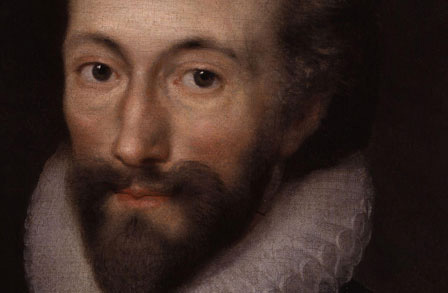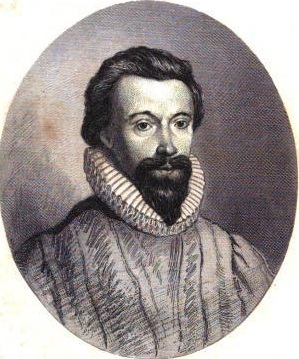About the poet – John Donne (1572 – 1631), called one of the foremost Metaphysical poets was the son of a prosperous London ironmonger and his mother was the daughter of John Heywood. He studied law and travelled the continent and though he was a voracious reader he never attained a university degree. His poetry falls broadly into three groups: satires, elegies and verse letters, songs, sonnets and divine poems. These three groups have an underlying impulse, the impulse to break away from the shackles of the conventions of poetry reigning in English literature. To Donne the mood of abject acquiescence to lady love is something quite repulsive, because he feels that it runs counter to the psychology of man, man composed of diverse emotions and feelings. He is a singular poet who with the zeal of a crusader, debunks the sublime and elevated strain unrelated to the lowly and mean impulses of man.
Summary and Analysis of The Extasie by John Donne
The poem deals with Donne’s metaphysics of love. It presents the communion of two souls of a loving couple on a grassy turf beside a river, untouched by carnal passions. The physical aspect of love-making finds no mention here. The lovers are engrossed in the thought of an abiding union and are animated by the impulse to coalesce and fuse into one. The poem presents the lovers in a trans like state when both of them appear to be verging on being oblivious of their carnal life.
Donne’s typical method is to present an idea in terms of concrete images. The images become emotional equivalent of his thought. Let us see how he presents the unforgettable idea of a beatific experience through the image of ‘extasie’ reinforced by a wealth of images culled from different spheres of life.
There is a pun on the title word, ‘extasie’. In the modern sense it refers to the trans-like state the lovers have entered into. But the original Greek meaning takes us to the heart of the poem. The Greek word, ‘ekstasis’ means ‘going forth’. The souls go out of their respective bodies. They have a dialogue ruminating over their communion, and surprisingly enough, there is a bystander who is within a convenient distance from there. This third person is no impediment in their love-making on the spiritual plane. He appears to be device invented by the poet, adding substance to their highfalutin experience, either by testifying to the veracity of the experience or by also coming under the spell of their ecstatic vision. Here the poet’s mood is romantic, bringing in the violet, a conventional image of love, reclining on the pregnant bank, but the pictorial description of the visual beauty simply enhances the intensity of their love without any romantic gloss, and it is much in keeping with the mood of the poet. The expression, ‘balm’ also rightly finds company in the sweet –smelling violet evoking the right ambience. This image of the violet which has a visual beauty recurs later in the poem with a changed connotation without any romantic association. Here we have the botanical expression, ‘grafting’, as a variation in a different way on the image, ‘to engraft our hands’, used at the outset of the poem. The two images: the images of engrafting hands and transplanting of a violet-work in conjunction with each other. The former implies the removal of their separateness and their emerging into a single identity and the latter speaks of the strengthening of the weaker breed of the violet in a richer soil. It is symbolic of the creation of a new soil that is bereft of all weaknesses.
A single . . .
. . . . . . . . . . .
. . . and multiplies.
The poet does a remarkable feat of imagination by finding the image of a jeweler threading pearls on a string. The lovers are lost in gazing at each other in such a way that there is perhaps, the optical illusion of their eyes being on a double string. It appears to be hyperbole that the eyeballs are on the string, and only justification for this image is that it is suggestive of their becoming one. The lovers find themselves on the same emotional wave-length and from this rapport they establish it appears that all hostilities cease other reflected in their eyes suggest an addition of pictures. The word ‘propagation’ apparently suggests an increase in spiritual grandeur.
The fourth stanza presents the core of the experience of oneness of the lovers. The soul here takes the lead and the body lies still and inert. The soul is engaged in a mission and accomplishes the task with a remarkable serenity and aplomb. The image comes to us in an expanded form. It is the image of two equal armies, arrayed against each other and awaiting announcement of victory in the battlefield by fate. The expression, ‘equal armies’ shows the attitude of the poet towards lovers in the sense that in the Petrarchan vein there is one sided love-making, that is, the lover adores the beloved as if the latter were a duty and the former a vassal, but here both are on par with each other without having an edge over the other. The body becomes quiescent and the soul is resplended with spiritual ecstasy.
In stanza V we have another elaborate simile that describes the physical condition of the lovers. They are compared to statues in a tomb from where the soul has gone out. The image of the ‘transplant’ is picked up in stanza XI in a different manner. The concept here is of ‘interanimation’, and this is on physiological as well as metaphysical plane. It is the rejuvenation of the phoenix-like soul ravaged by loneliness. With this reshaping of the soul in a new mould the lovers have the feeling that they are beyond the inexorable law of change, decay and death. Time has no effect on them, because they have reached the state of timelessness. They have passed beyond the confines of the temporal world and enjoy a state of bliss, and the poet rightly says, “ . . . whom no change can invade.”
But later in the poem there is a transition from the world of timelessness to the mortal coil of life. The poet talks about the descent of the soul into the body. Many critics take it to be a denouement that after celebrating the ecstatic union on the spiritual plane the poet talks about their coming back to the body. It is no anti-climax because in the Donne universe there is no segregation of soul and body in hermetically sealed boxes, and this interanimation is a subtle process which invigorates and enriches the life. Without the incarnation of the beatific vision in the body it remains shadowy, chimerical and ethereal. Stanza XVI is pregnant with deep physiological implication:
As our . . .
. . . which makes us man.
The blood begets spirit, the spirit goes into the brain, the brain gives direction to the muscle and this gives rise to an interrelated being. This interrelation brings the image of ‘subtile knot’. This complex character of man envisages a blend of soul and body: “the union of soul and body, through the working of the spirits ‘makes us man’”(Helen Gardner).
Some online learning platforms provide certifications, while others are designed to simply grow your skills in your personal and professional life. Including Masterclass and Coursera, here are our recommendations for the best online learning platforms you can sign up for today.
The 7 Best Online Learning Platforms of 2022
- Best Overall: Coursera
- Best for Niche Topics: Udemy
- Best for Creative Fields: Skillshare
- Best for Celebrity Lessons: MasterClass
- Best for STEM: EdX
- Best for Career Building: Udacity
- Best for Data Learning: Pluralsight














Thank you for making it easy to understand sir….
This is one of the best answers I found online.
can you explain metaphysical poetry and its salient features